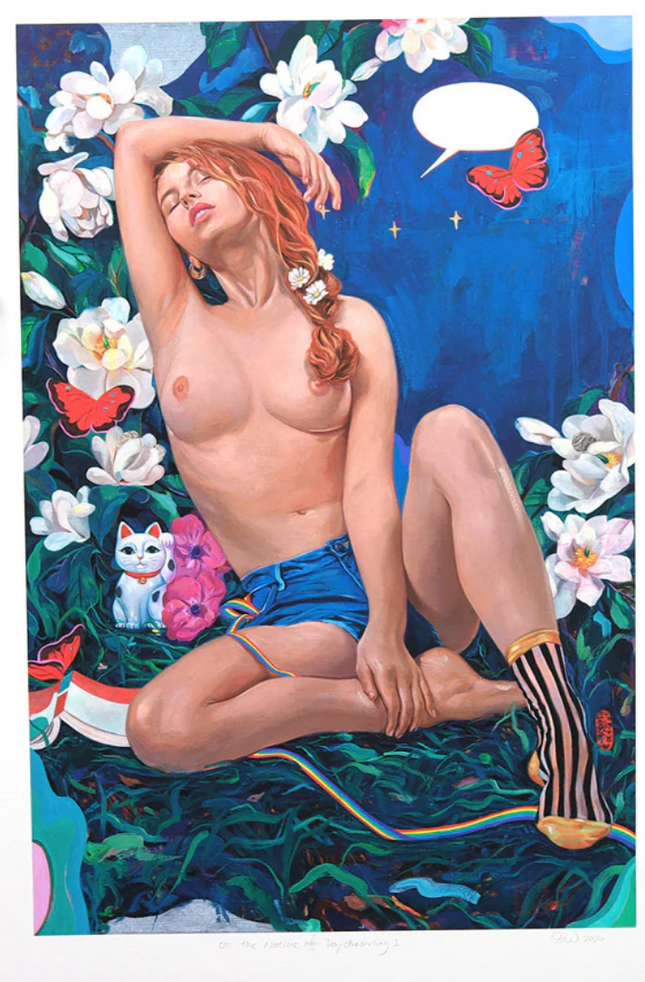
China

Helice Wen In The Nature of Daydreaming No 2 PP HPM Archival Print by Helice Wen
In The Nature of Daydreaming No 2 PP HPM Archival Print by Helice Wen Limited Edition Hand Painted Multiple on 290gsm Fine Art Paper Pop Artist Modern Artwork. PP Printers Proof 2020 Signed & Marked PP HPM Acrylic Paint Hand Embellished Print Limited Edition Artwork Size 17x24 Archival Pigment Fine Art. Exploring the Fusion of Street Pop Art and Graffiti in Helice Wen's "In The Nature of Daydreaming No 2" The art world has witnessed a captivating blend of styles and mediums in recent times, exemplified by Helice Wen's "In The Nature of Daydreaming No 2". This piece is a stellar example of how modern artists are intertwining elements of street pop art and graffiti to create innovative, visually striking artworks. Released in 2020, this limited edition hand-painted multiple (HPM) archival print showcases Wen's unique vision, merging traditional fine art techniques with the raw, expressive energy of street art. Helice Wen, an artist renowned for her emotional and evocative work, brings a fresh perspective to pop art. Her piece "In The Nature of Daydreaming No 2" is particularly notable for its use of acrylic paint on 290gsm fine art paper, a choice that speaks to the blend of durability and delicacy in her work. The artwork, measuring 17x24 inches, is a testament to her mastery of both scale and detail. The Significance of Printers Proof (PP) in Contemporary Art The PP, or Printers Proof, edition of this artwork holds a special place in the art community. Traditionally, printer's proofs were seen as a part of the printmaking process, reserved for the printer's use and not typically for sale. However, in contemporary art, these proofs have gained value as unique pieces, often more sought-after than standard editions due to their rarity and the direct involvement of the artist. Wen's decision to sign and mark this piece as a PP HPM further elevates its exclusivity and appeal to collectors. Hand Embellishment: A Bridge Between Fine Art and Street Aesthetics The hand-embellished nature of this artwork is a crucial aspect of its charm and value. Hand embellishments in art involve the artist adding individual touches to each print, making every piece in the edition unique. In the context of Wen's work, this practice blurs the line between traditional fine art prints and street art's spontaneity and individualism. The use of acrylic paint for hand embellishments in "In The Nature of Daydreaming No 2" not only adds texture and depth to the piece but also infuses it with the raw energy characteristic of graffiti. Archival Quality and Its Role in Modern Art Preservation The use of archival pigment in fine art is another aspect that sets Wen's work apart. Archival pigments are known for their long-lasting quality, ensuring that the artwork does not fade or deteriorate over time. This longevity is essential for collectors and art enthusiasts who view the purchase of such pieces as an investment. The 290gsm fine art paper used in this print further contributes to its durability, striking an optimal balance between weight and texture. In summary, Helice Wen's "In The Nature of Daydreaming No 2" is a fascinating example of how contemporary artists are melding the worlds of street pop art, graffiti, and fine art. Through her choice of medium, hand embellishments, and attention to archival quality, Wen has created a piece that not only stands out in the modern art landscape but also challenges and expands the boundaries of traditional art forms.
$600.00


